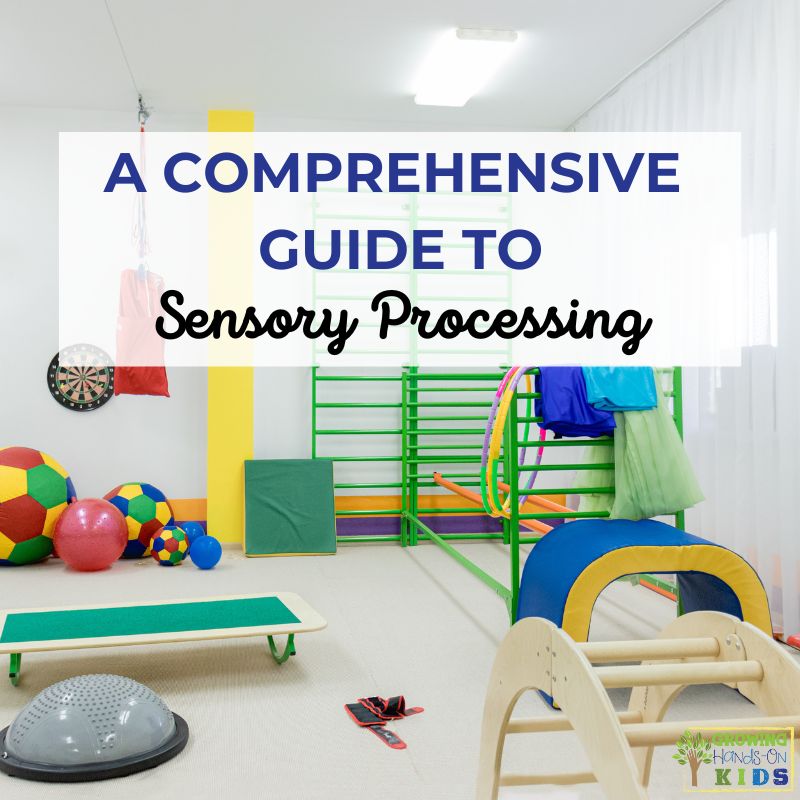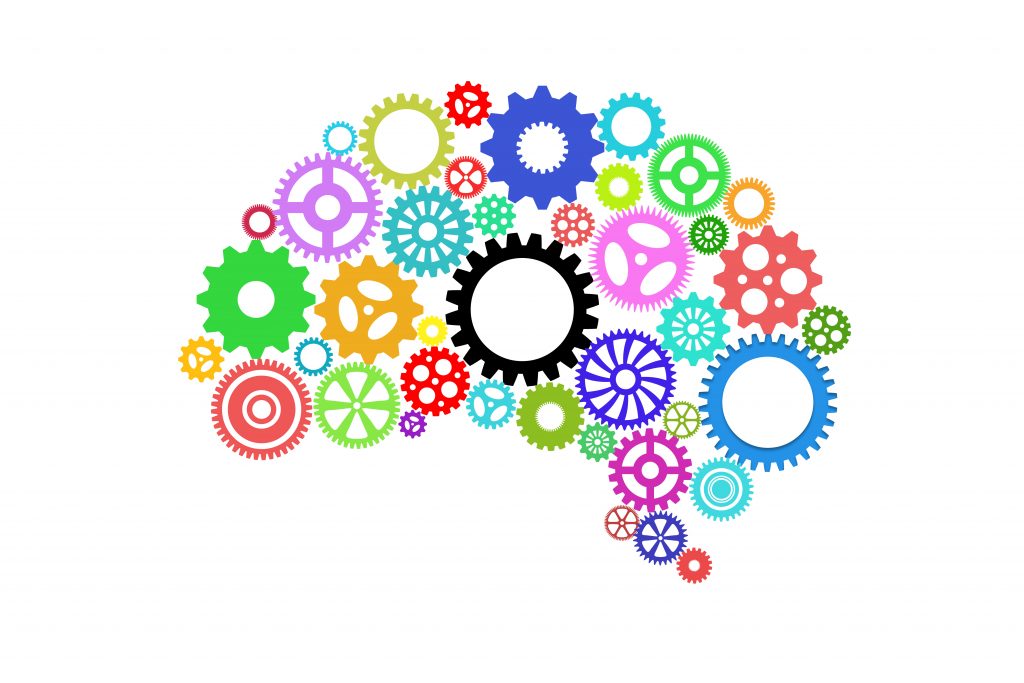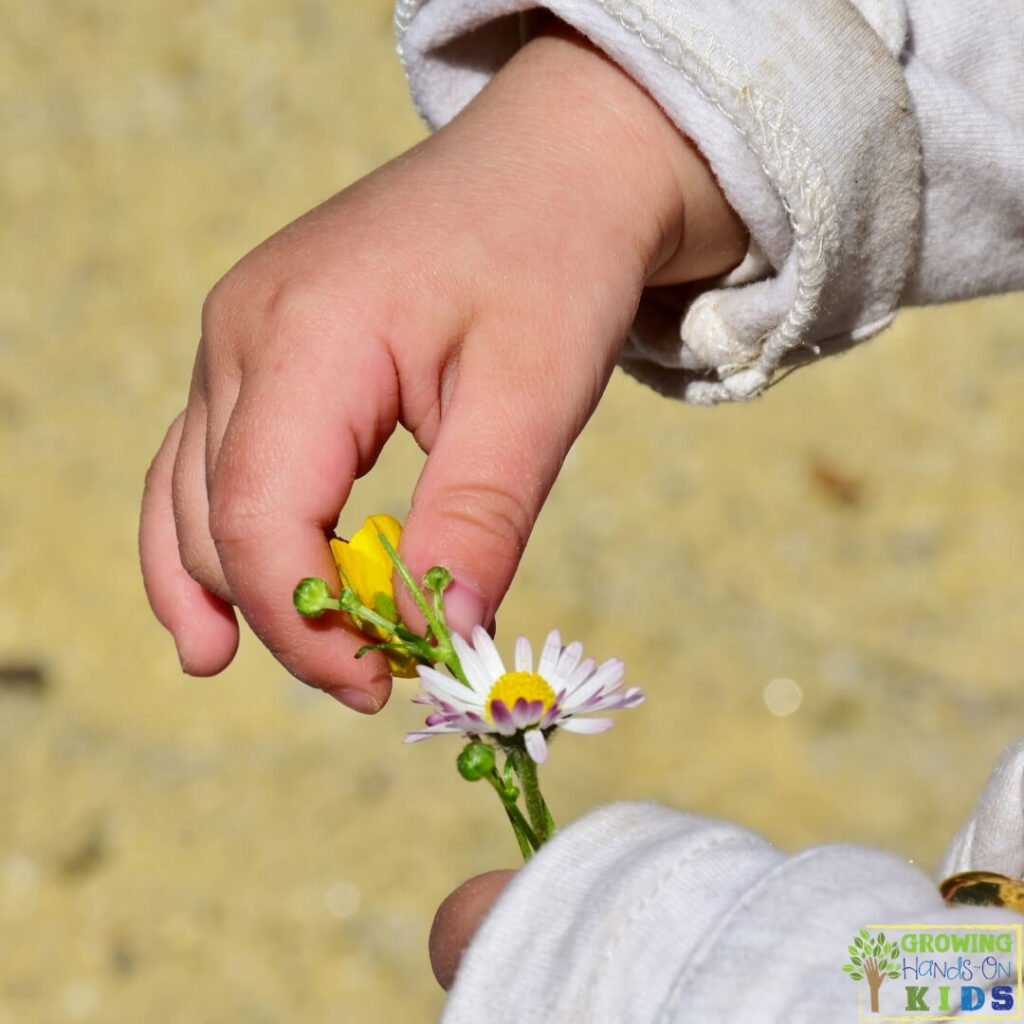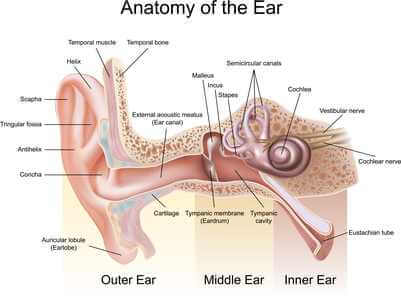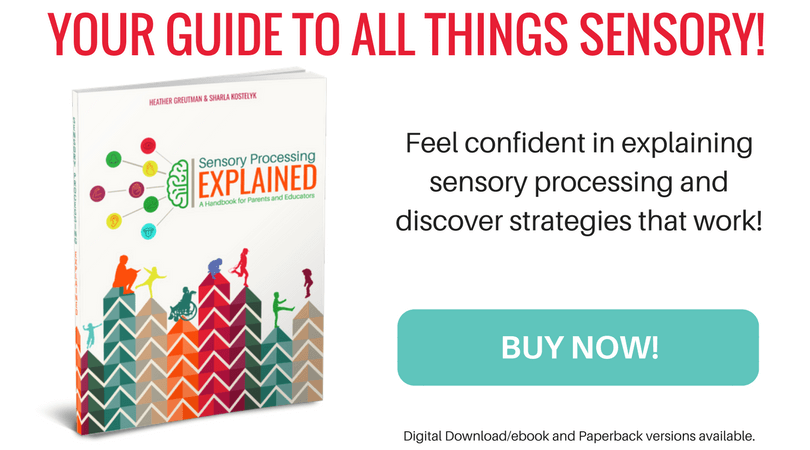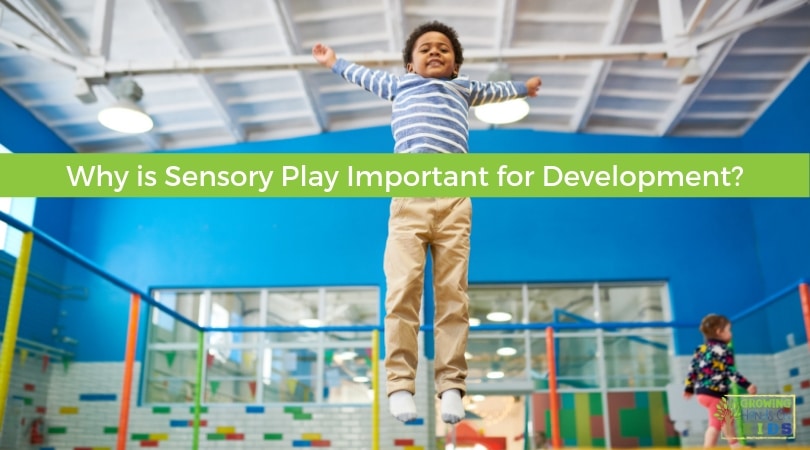A Comprehensive Guide to Sensory Processing
Affiliate and Referral links are used below to promote products I love and recommend. I receive a commission on any purchases made through these links. Please see my disclosure policy for more details. As an Amazon Associate, I earn from qualifying purchases.
This guide is an introduction to sensory processing. I'll define sensory processing, describe how it’s involved in daily life, and identify the sensitivity signs. Plus, I'll give you strategies and activity ideas to help a student or child who may be struggling with sensory processing challenges.
My hope is that you will come away from this post with a better understanding of sensory processing, how it can affect your child's life, and strategies you can use to help support them.
For professionals, this is a great post to share with your families or clients.
What is sensory processing?
The sensory system is comprised of the brain, spinal cord, and neurons. It is the neurological wiring by which we perceive and process sensory information coming from outside and even inside our bodies. All of this information travels through the nervous system to the brain where it is interpreted and the brain tells our body how to respond.
All the systems working together provide you with the “optimal level of arousal”, which means you are able to perceive, process, and react to sensory stimuli and information in a timely manner.
When a person or child has sensory overload or low arousal, this is often referred to as sensory processing difficulties or sensory processing disorder (SPD). It basically means that their brains are “wired” differently and they have difficulty processing incoming sensory information.
I'll share more about SPD later on in this article.
What are the 8 senses?
There are 8 main senses that we are going to talk about today.
- Tactile/touch
- Auditory/Hearing
- Visual/Sight
- Taste/Gustatory
- Olfactory/Smell
- Proprioception
- Vestibular
- Interoception
We are going to take a look at each sensory system in detail below.
Types of Sensory Processing Responses
There are 3 types of responses when it comes to how the brain responds to sensory input.
Hyper-responsive (also known as over-responsive or hypersensitivity) -“Sensory Avoiders or Sensory Avoiding” -These children are excessively responsive to sensory input. The slightest movement, touch, or sound could send you or a child into a negative behavior response.
Hypo-responsive (also known as hyposensitivity) -“Sensory Seekers or Sensory Seeking” – This child does not receive enough sensory input and is constantly looking for it to get to that “just-right” level of arousal. These behaviors can impact their day because they are not able to focus or attend to tasks until they are at that just-right level.
Under-responsive – These children exhibit a diminished response to sensory input. More sensory input is needed than average in order to get a response. They can look like they are “lazy” or “tired”.
Each system has a “hyper” or “hypo” or “under” type of response that you will see in children. You might notice both responses for the same sensory system depending on the activity (especially if it is a new “novel” experience, versus something the child has experienced before). It is also common to be hyper-responsive to some of the sensory systems and hypo-responsive or under-responsive to others.
You can read more about Sensory Seekers vs. Sensory Avoiders here.
The Tactile System – Sense of Touch
The tactile system is often the most commonly recognized sensory system of the body. It is also the one people most often notice if a child has an overactive or underactive sensitivity. Anything you touch or feel is part of this system.
You may notice some of these sensory challenges if your child has a sensitivity to touch:
- avoids messy hands, face, or just mess in general
- unaware if hands or face are messy
- difficulty with certain clothing items such as tags and may avoid getting dressed or only wear certain types of clothing
- needs to touch everything (brushing along walls while walking, picking up everything).
- seeks out physical contact and touch
- avoids hugs or physical contact with others
- needs to fidget in order to focus or when bored
- highly sensitive to temperature changes or may avoid or crave certain temperatures (hot or cold)
- highly sensitive to small cuts or scrapes (low or high pain tolerance).
- avoids self-care tasks such as brushing teeth, brushing hair, getting a haircut, or having nails trimmed
Some strategies for sensitivity to the tactile system include:
- sensory bins with various textures
- use weighted blankets or lap pads
- play dough or finger painting
- deep pressure either by rolling an exercise ball across the back or squeezing the hands
- using a stress ball for hand squeezes or hand fidgets
- put finger paint in a plastic bag and have them paint from outside the bag by moving the paint around in the bag with their fingers
- use tag-less clothing
- massage their scalp before haircuts (deep pressure scalp massage)
- weighted vest at the dentist or other anxiety-inducing outings that include tactile input
- shaving cream finger paint (write their names, copy shapes or letters/numbers)
Here are some more resources for the sense of touch:
The Auditory System – Sense of Hearing
This includes hearing, listening, interpreting, localizing sounds, and being able to filter and selectively attend to auditory stimuli.
Some challenges for sensitivity to auditory input include:
- Sensitivity to loud, sudden sounds
- Distracted by background noises
- Does not speak as well as others their age
- Has a significant history of ear infections
- Covers their ears often to block sound
- Asks others to repeat what they said
- Has trouble with phonics and learning to read
- Unusually high volume or low volume in their voice
- Often seems to ignore parents or teachers
With hearing, it is important to make sure that there is nothing going on medically with their ears such as hearing loss, chronic ear infections etc. This should be addressed first before seeing if your child or student has auditory processing challenges.
Some strategies for sensitivity to the auditory system include:
- Use headphones or earplugs to block out background noises
- Give extra time for the child to process what you told them
- Use visuals such as a visual schedule or visual prompts for directions
- Simplify language when giving instructions to your child or in the classroom
- Give a verbal or visual warning before loud sounds (like fire drills) to cover ears.
- Try Therapeutic Listening programs (usually this involves specialized training and an Occupational Therapist to assess)
- Include a rain stick in your sensory space or room
- Musical instruments such as shakers or learning to play an instrument
- Calming, soft music to encourage regulation and self-calming
- Use a white noise machine, fan, etc.
- Play clapping games
Here are more resources for the sense of hearing:
The Visual System – Sense of Sight
The visual system includes using our eyes to see what is far or close to us. A typical person is able to use smooth and precise eye movements to scan and visually assess their environment.
Difficulties with the visual system can prevent a child from focusing and completing tasks. Visual sensitivities can affect acuity, ocular motor, visual motor, and visual perception.
Some challenges for sensitivity to visual input include:
- Sensitive to sunlight or fluorescent lights
- Overly distracted by classroom or home wall decorations
- Poor hand-eye coordination
- Difficulty tracking across a page while reading
- Difficulty copying from the chalkboard
Some strategies for sensitivity to the visual system include:
- Decrease wall decorations
- Adjust the lighting in the classroom or home (cover fluorescent lights or turn them off and use natural light or lamps).
- Use a table easel to bring the working surface to a more upright position
- Use a window guide and/or colored overlays for reading
- Copy from page or book at close range instead of a chalkboard
- Make sure the screen and monitors are at a proper height
- Focus on eye-hand coordination activities such as playing catch
Here are more resources for the sense of sight:
The Olfactory System – Sense of Smell
When we eat, we smell something first. If it smells good we are more likely to try it. If it smells bad that sends a warning that we may not like it OR that it is dangerous for us to eat. Smell travels through chemical receptors with direct neuronal connections to the limbic system (responsible for emotional memory). This is often why our emotions are tied to smells and food.
If you have a child with olfactory sensitivity, you may notice the following:
- Overly sensitive to certain smells and avoids them
- Limited diet (gagging or avoiding)
- Explores objects by smelling
- Craves certain smells or textures
- Holds their nose to avoid smells, even if you don’t smell anything
- Avoids foods most children their age enjoy
Here are some activity ideas to help with olfactory sensitivities:
- Scented play dough, finger paints, or sensory dough
- Use scented markers or stickers
- Create smelling bottles with various spices or items to introduce new smells
- Use scented bubbles
- Scented chewable items
- Avoid scented soaps, lotions, perfumes, and essential oils (especially if there are respiratory issues such as Asthma as these could be a trigger)
- Visit a herb garden
Here are more resources for the sense of smell:
The Gustatory System – Sense of Taste
You may recognize the gustatory system more by the word taste or oral sensory system. Taste and smell or the olfactory system are very closely related.
If your child has taste sensitivities you notice some of the following symptoms:
- Sensitive to brushing teeth (hypersensitive)
- Sensitive to food textures (hypersensitive)
- Mouthing non-food objects and exploring textures such as chewing on pencils, clothing, etc. – this is age-appropriate for young babies and toddlers
- Frequent drooling
- Loves or has a strong fear of going to the dentist
Some activity ideas to help with these sensitivities include:
- Chewing gum
- Chewable jewelry or chewable tool/toy
- Vibrating toothbrush
- Drinking from a straw (sucking can be focusing and help with attention, especially thicker items like a smoothie or milkshake)
- Creating tasting bottles of various safe items with scents or flavors (sweet, salty, sour, etc)
- Blowing bubbles
- Exploring textures through sensory bins or messy sensory play
- Blowing out candles
- Drinking through a sports bottle
Here are more resources for the sense of taste:
The Proprioceptive System (Proprioception) – Sense of Body Awareness
The proprioceptive system or proprioception is one of the internal senses of the body that comes from the joints, muscles, ligaments, and other connective tissue. The proprioception system allows you to know where your body parts are and what they are doing without necessarily looking at them.
The receptors are in the joints, muscles, and tendons and perceive contraction, stretching, and compression.
We all know of a child, maybe he/she sat in front of you in school, or maybe it was you that the teacher was always yelling at to sit down or slow down. At play, this child may always be literally “bouncing off the walls” or falling down. These children are seeking sensory input into their joints or muscles.
Symptoms of proprioceptive needs include:
- Poor body awareness – knowing where their body or body parts are in space
- Poor coordination – they move awkwardly or stiffly
- Difficulty grading amount of pressure – using excessive force on an object (such as breaking a -pencil or crayon when writing or coloring or not enough pressure)
- May push, hit, bite, or bang into other children
- Avoid or crave jumping, crashing, pushing, pulling, bouncing or hanging
- Chew on clothing or objects more than other children
- Have to look at what they are doing (staring at their feet while walking or running)
Activities to help proprioception challenges can include:
- Weighted lap pads or vests
- Bean bag chair to sit in
- Heavy work activities
- Swimming
- Karate
- Climbing
- Playing in a sandbox
- Carry groceries
- Wearing lycra
- Chair push-ups
- Dancing
- Washing the car
- Rolling a ball
- Yoga Stretches
- Pillow fights
- Chewing bubble gum
- Using the monkey bars at the playground
More resources for proprioception:
The Vestibular System – Sense of Balance
The vestibular system is located in the inner ear and helps you to detect changes in regard to gravity. Are you sitting, standing, lying down, upside down, spinning, standing still, etc? It is often referred to as the internal GPS system of your body.
It is also very closely linked to the proprioception, auditory, and visual senses of the body. That is why when a person or child has sensory processing challenges, the Occupational Therapist will often start with addressing any issues they have with their vestibular system.
Symptoms of vestibular sensitivity or needed input include:
- Gravitational insecurities – will become very upset when movement is forced on them
- Movement intolerance – uncomfortable with fast movement or spinning
- Craves spinning or swinging
- Does not like feet off the ground – fearful of heights, fear of falling
- Has difficulty standing still – is constantly moving (fidgets)
- Prone to being carsick or motion sick – this can also manifest as falling asleep immediately in a car, bus, boat, or airplane)
- Becomes dizzy easily, or never becomes dizzy
Activity ideas include:
- Using a ball chair or wiggle cushion for seated activities
- Use movement breaks
- Jumping on a trampoline
- Swinging
- Riding a bike
- Yoga poses
- Using a scooter board
- Sit and spin chairs
- Rolling down a hill
- Balance beams or lines
- Jumping rope
More resources for the vestibular system:
The Interoception System – Internal Sense & Emotional Regulation
If you've never heard of this 8th sense, don't worry. I didn't even know it existed until a few years ago when I learned about it in a continuing education class.
The problem is, that not a lot of research has been done on interoception. Today I want to help answer the question “What is interoception?” and help to de-mystify this 8th sensory system a little bit.
Interoception is the sense of knowing what is going on INSIDE our bodies.
Things such as feeling:
- Hunger
- Thirst
- Tired
- Feeling pain
- Temperature (Feeling hot or cold etc)
- Using the bathroom
- Any other internal sensations
So what are some “signs” that a child may be struggling with interoception input?
- Difficulty with toileting (bed wetting and accidents)
- Unable to track hydration or food intake (never feel thirsty or hungry. Or may always feel thirsty or hungry)
- Difficulty in recognizing and communicating internal body states or sensations (feeling hot/cold, pain, etc)
- Difficulty regulating emotions and feelings (not feeling they are angry before they verbally or physically lash out)
- Distracted by internal sensory input such as hearing their heartbeat
- Unable to tell how loud their voice is in an environment, may use sound to cover up unwanted sensory stimuli
There is not a lot of research yet, but here are some suggested activities to help:
- Mindfulness activities
- Yoga
- Heavy work activities
- Alerting activities
- Repetitive and rhythmic vestibular input
- Visual prompts and cues to identify and communicate emotions
- Social stories
More resources for the interception system:
Sensory Processing Disorder/Sensory Processing Challenges
You will often see sensory processing issues or challenges referred to as sensory processing disorder.
While sensory processing challenges are REAL for many children and individuals, sensory processing disorder is NOT a recognized diagnosis in the DSM-5 (Diagnostic and Statistical Manual of Mental Disorders).
One of the reasons for this is sensory processing challenges are extremely hard to assess with standardized measures or tests. Each child or person needs to be assessed on an individual level and there is no set standard of treatment because of this.
For educational purposes, I am going to share the 6 subtypes of sensory processing disorder. It is again important to note that these are not diagnoses that you would ever see in your child's medical file or chart. However, it does help therapists specifically Occupational therapists, identify where your child may be struggling with sensory processing.
Sensory Modulation Disorder – This includes sensory over-responsive, sensory under-responsive, and sensory craving (as we discussed further up in this article)
Sensory-Based Motor Disorder – Postural Disorder and Dyspraxia – Children with these sensory challenges have difficulty with balance and motor coordination.
Postural disorder specifically includes difficulty with core strength and impaired body awareness. Dyspraxia is difficulty planning and completing motor movements, especially for a task that may be new to them.
Sensory Discrimination Disorder – Difficulty interpreting sensory stimuli from the 8 senses mentioned above.
You can read more about the sub-types of SPD here.
Sensory processing challenges can be seen with other diagnoses such as ADD/ADHD, Autism Spectrum Disorder, depression, anxiety, etc.
Treatment for Sensory Processing Problems
If you feel your child or student may be struggling with sensory processing difficulties, start by ruling out any physical or medical issues such as eyesight, hearing, etc. Then, ask for an Occupational Therapy evaluation by a therapist who is trained in sensory integration strategies.
Speech and Language Pathologists and Physical Therapists, along with Psychologists, or other professionals may also be beneficial, depending on your child's challenges.
Treatment should be family-centered and also be individualized based on your child's strengths and sensory challenges. Sensory integration therapy can also include things like therapeutic listening programs or relationship-based (DIR-Floor) models.
More Reading on Sensory Processing Challenges
There is so much more to sensory processing that I could not adequately cover in this article. That is why I co-authored Sensory Processing Explained: A Handbook for Parents and Educators with my dear friend Sharla Kostelyk.
With Sensory Processing Explained, discover…
- easy-to-understand sensory information that you can share with parents and educators to help explain a child's behavior
- how to explain sensory processing to those who just don't get it
- what calming techniques and strategies can work during a sensory meltdown
- easy sensory ideas to replicate at home
- how teachers can accommodate kids with sensory processing challenges
- strategies and activities that can be used with an entire classroom
- information on all eight sensory systems and how they can affect behaviors (plus strategies and activities that can help with regulation)
- just figuring out where to begin if you feel a child could be struggling with sensory processing
Plus get amazing informational printables that make it easy to share about sensory processing with families, clients, or co-workers.
You May Also Like:

Heather Greutman, COTA
Heather Greutman is a Certified Occupational Therapy Assistant with experience in school-based OT services for preschool through high school. She uses her background to share child development tips, tools, and strategies for parents, educators, and therapists. She is the author of many ebooks including The Basics of Fine Motor Skills, and Basics of Pre-Writing Skills, and co-author of Sensory Processing Explained: A Handbook for Parents and Educators.

